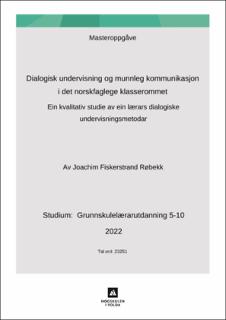Dialogisk undervisning og munnleg kommunikasjon i det norskfaglege klasserommet. Ein kvalitativ studie av ein lærars dialogiske undervisningsmetodar
Master thesis
Permanent lenke
https://hdl.handle.net/11250/3014730Utgivelsesdato
2022Metadata
Vis full innførselSamlinger
Sammendrag
Føremålet med denne studien er å finne ut kva metodar ein lærar kan nytte for å skape meiningsfull dialog i klasserommet, korleis dette kan auke elevane sin munnlege kompetanse og kva dette kan ha å seie for elevane si læring. Hovudproblemstillinga for denne studien blir derfor: Korleis går læraren fram for å skape og utføre dialogisk undervisning med føremål om å utvikle elevane sin munnlege kompetanse i norskfaget?
Tema for studien er dialogisk undervisning på ungdomstrinnet med fokus på læraren sine metodar i undervisninga. Eg har undersøkt korleis dialogen oppstår i klasserommet, der funn viser at dialogen oppstår både planlagd og spontant. Planlagd dialog er kjenneteikna ved at læraren tar i bruk ulike metodar for å skape meiningsfull dialog i klasserommet, i tillegg til at dialogen er prega av eit tydeleg fagleg innhald. Den spontane dialogen oppstår ofte utan forvarsel i klasserommet, oftast på initiativ frå elevane utan noko spesielt fagleg grunnlag. Eit av hovudfunna i denne studien er at desse typane av dialog i klasserommet har til felles er at dei begge er med på å utvikle elevane sin munnlege kompetanse. Ein kan derfor seie at både den planlagde og den spontane dialogen er like viktig innanfor den dialogiske undervisninga.
Eit føremål med den dialogiske undervisninga er å fremje læring og skape eit meir autonomt læringsmiljø, der elevane får høgare grad av ansvar for eiga læring. Dette fritek ikkje læraren for arbeid, tvert imot. Læraren må i den dialogiske undervisninga tørre å gi slipp på noko av den autoritative styringa og kunnskapsformidlinga i klasserommet, og la elevane få meir av ansvaret i dialogen. I staden for å fungere som den tradisjonelle monologiske kunnskapsformidlaren der elevane resiterer kunnskap, må læraren heller ta ei større rolle som ordstyrar i klasserommet, eller rettare sagt ein dialogisk organisator. Abstract
Abstract The purpose of this study is to find out what methods a teacher can use to create meaningful dialogue in the classroom, how this can increase students 'oral competence and what this can mean for students' learning. The main issues for this study will therefore be: How does the teacher proceed to create and carry out dialogic teaching with the aim of developing the pupils' oral competence in the Norwegian subject?
The theme of the study is dialogic teaching at the lower secondary level with a focus on the teacher's methods in the teaching. I have investigated how the dialogue arises in the classroom, where findings show that the dialogue arises both planned and spontaneous. Planned dialogue is characterized by the teacher using different methods to create meaningful dialogue in the classroom, in addition to the dialogue being characterized by a clear academic content. The spontaneous dialogue often occurs without warning in the classroom, usually on the initiative of the students without any special academic basis. One of the main findings of this study is that these types of dialogue in the classroom have in common is that they both help to develop students' oral competence. One can therefore say that both the planned and the spontaneous dialogue are equally important within the dialogical teaching.
One purpose of the dialogic teaching is to promote learning and create a more autonomous learning environment, where students have a higher degree of responsibility for their own learning. This does not exempt the teacher from work, on the contrary. In the dialogic teaching, the teacher must dare to let go of some of the authoritative management and dissemination of knowledge in the classroom, and let the students get more of the responsibility in the dialogue. Instead of acting as the traditional monological communicator of knowledge where students recite knowledge, the teacher must take on a larger role as chair in the classroom, or rather a dialogical organizer.
